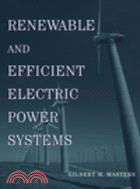| FindBook |
有 1 項符合
RENEWABLE AND EFFICIENT ELECTRIC POWER SYSTEMS的圖書 |
 |
RENEWABLE AND EFFICIENT ELECTRIC POWER SYSTEMS 作者:GILBERT M. MASTERS 出版社:全華經銷 出版日期:2004-08-11 規格:24.5*16.5cm / 精裝 / 654頁 |
| 圖書館借閱 |
| 國家圖書館 | 全國圖書書目資訊網 | 國立公共資訊圖書館 | 電子書服務平台 | MetaCat 跨館整合查詢 |
| 臺北市立圖書館 | 新北市立圖書館 | 基隆市公共圖書館 | 桃園市立圖書館 | 新竹縣公共圖書館 |
| 苗栗縣立圖書館 | 臺中市立圖書館 | 彰化縣公共圖書館 | 南投縣文化局 | 雲林縣公共圖書館 |
| 嘉義縣圖書館 | 臺南市立圖書館 | 高雄市立圖書館 | 屏東縣公共圖書館 | 宜蘭縣公共圖書館 |
| 花蓮縣文化局 | 臺東縣文化處 |
|
|
- 圖書簡介
This is a comprehensive textbook for the new trend of distributed power generation systems and renewable energy sources in electric power systems. It covers the complete range of topics from fundamental concepts to major technologies as well as advanced topics for power consumers.
An Instructor's Manual presenting detailed solutions to all the problems in the book is available from the Wiley editorial department -- to obtain the manual, send an email to ialine@wiley.com - 作者簡介
GILBERT M. MASTERS received his PhD in electrical engineering from Stanford University and has taught courses there for the past twenty-five years on energy and the environment, with an emphasis on efficiency and renewables. He is currently Professor (Emeritus) of Civil and Environmental Engineering at Stanford University and the author of several books on environmental engineering.
- 名人/編輯推薦
"…provides readers a comprehensive understanding of distributed power-generation systems and renewable energy technologies." (Solar Today, September-October 2005)
"In an era of 'bad' science encountered almost daily in publications and the media, it is refreshing to find this work of solid engineering excellence." (CHOICE, February 2005)
"…this book has much to offer...it gives the patron excellent background and practical current information. It is highly recommended..." (E-STREAMS, February 2005) - 目次
Preface.
1 Basic Electric and Magnetic Circuits.
1.1 Introduction to Electric Circuits.
1.2 Definitions of Key Electrical Quantities.
1.3 Idealized Voltage and Current Sources.
1.4 Electrical Resistance.
1.5 Capacitance.
1.6 Magnetic Circuits.
1.7 Inductance.
1.8 Transformers.
2 Fundamentals of Electric Power.
2.1 Effective Values of Voltage and Current.
2.2 Idealized Components Subjected to Sinusoidal Voltages.
2.3 Power Factor.
2.4 The Power Triangle and Power Factor Correction.
2.5 Three-Wire, Single-Phase Residential Wiring.
2.6 Three-Phase Systems.
2.7 Power Supplies.
2.8 Power Quality.
3 The Electric Power Industry.
3.1 The Early Pioneers: Edison, Westinghouse, and Insull.
3.2 The Electric Utility Industry Today.
3.3 Polyphase Synchronous Generators.
3.4 Carnot Efficiency for Heat Engines.
3.5 Steam-Cycle Power Plants.
3.6 Combustion Gas Turbines.
3.7 Combined-Cycle Power Plants.
3.8 Gas Turbines and Combined-Cycle Cogeneration.
3.9 Baseload, Intermediate and Peaking Power Plants.
3.10 Transmission and Distribution.
3.11 The Regulatory Side of Electric Power.
3.12 The Emergence of Competitive Markets.
4 Distributed Generation.
4.1 Electricity Generation in Transition.
4.2 Distributed Generation with Fossil Fuels.
4.3 Concentrating Solar Power (CSP) Technologies.
4.4 Biomass for Electricity.
4.5 Micro-Hydropower Systems.
4.6 Fuel Cells.
4.6.7 Electrical Characteristics of Real Fuel Cells.
4.6.8 Types of Fuel Cells.
4.6.9 Hydrogen Production.
5 Economics of Distributed Resources.
5.1 Distributed Resources (DR).
5.2 Electric Utility Rate Structures.
5.3 Energy Economics.
5.4 Energy Conservation Supply Curves.
5.5 Combined Heat and Power (CHP).
5.6 Cooling, Heating, and Cogeneration.
5.7 Distributed Benefits.
5.8 Integrated Resource Planning (IRP) and Demand-Side Management (DSM).
6 Wind Power Systems.
6.1 Historical Development of Wind Power.
6.2 Types of Wind Turbines.
6.3 Power in the Wind.
6.4 Impact of Tower Height.
6.5 Maximum Rotor Efficiency.
6.6 Wind Turbine Generators.
6.7 Speed Control for Maximum Power.
6.8 Average Power in the Wind.
6.9 Simple Estimates of Wind Turbine Energy.
6.10 Specific Wind Turbine Performance Calculations.
6.11 Wind Turbine Economics.
7 The Solar Resource.
7.1 The Solar Spectrum.
7.2 The Earth’s Orbit.
7.3 Altitude Angle of the Sun at Solar Noon.
7.4 Solar Position at any Time of Day.
7.5 Sun Path Diagrams for Shading Analysis.
7.6 Solar Time and Civil (Clock) Time.
7.7 Sunrise and Sunset.
7.8 Clear Sky Direct-Beam Radiation.
7.9 Total Clear Sky Insolation on a Collecting Surface.
7.10 Monthly Clear-Sky Insolation.
7.11 Solar Radiation Measurements.
7.12 Average Monthly Insolation.
8 Photovoltaic Materials and Electrical Characteristics.
8.1 Introduction.
8.2 Basic Semiconductor Physics.
8.3 A Generic Photovoltaic Cell.
8.4 From Cells to Modules to Arrays.
8.5 The PV I –V Curve Under Standard Test Conditions (STC).
8.6 Impacts of Temperature and Insolation on I –V Curves.
8.7 Shading impacts on I–V curves.
8.8 Crystalline Silicon Technologies.
8.9 Thin-Film Photovoltaics.
9 Photovoltaic Systems.
9.1 Introduction to the Major Photovoltaic System Types.
9.2 Current–Voltage Curves for Loads.
9.3 Grid-Connected Systems.
9.4 Grid-Connected PV System Economics.
9.5 Stand-Alone PV Systems.
9.6 PV-Powered Water Pumping.
APPENDIX A: Useful Conversion Factors.
APPENDIX B: Sun-Path Diagrams.
APPENDIX C: Hourly Clear-Sky Insolation Tables.
APPENDIX D: Monthly Clear-Sky Insolation Tables.
APPENDIX E: Solar Insolation Tables byCity.
APPENDIX F: Maps of Solar Insolation.
Index.
|











